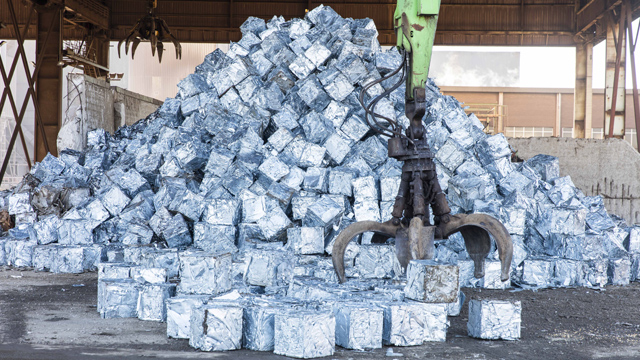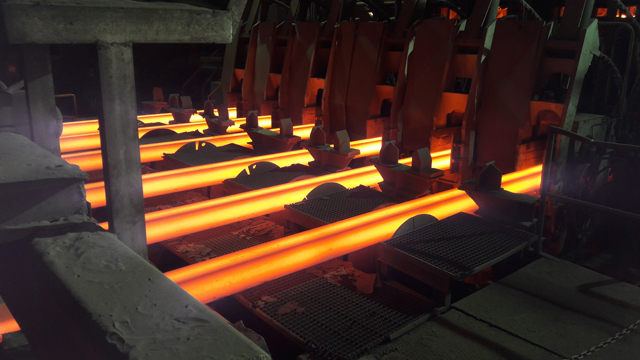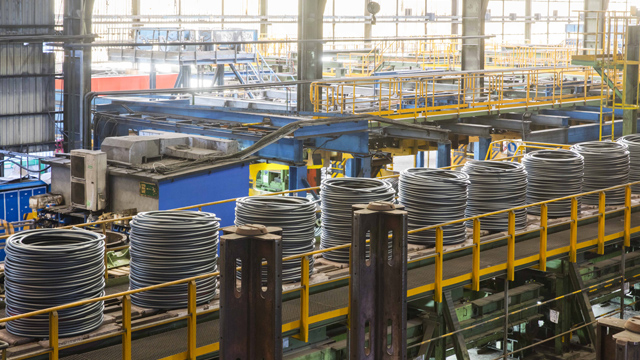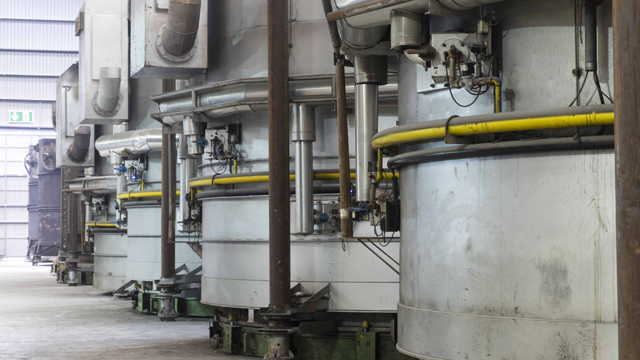Products
Manufacturing Process
Global Steel Wire manufactures steel by recycling scrap, thereby contributing to the conservation of the environment. Its industrial process, completely ecological, uses scrap metal as its fundamental raw material, melting it in a steelworks made up of an electric furnace, to obtain steel in the form of a semi-product called billet.
This billet is subsequently transformed in a rolling mill into a wide range of different qualities of wire rod, which are used by our customers to manufacture products such as wires, cords, cables, meshes, steel ropes, springs, stamped screws cold or tire reinforcement.
We have an IPP (Product and Process Engineering) department dedicated to research and development activities that allow us to offer the most technologically advanced products, a key aspect to be able to compete in increasingly demanding markets.</p >
The manufacturing process is summarized in these 4 steps:

1. Raw material: scrap
The metal load of each casting is made up of an appropriate mixture of selected scrap and pre-reduced mineral pellets to obtain the appropriate residual element content according to the type of steel to be manufactured.
The use of pre-reduced mineral pellets allows obtaining very low levels of residual element content, such as: Cr, Ni, Cu, Mo, Sn and N2.
Both scrap and pre-reduced materials, as well as the rest of the raw materials (ferroalloys, fuels and slagging agents) are acquired in accordance with the technical purchasing specifications, from approved suppliers and subject to periodic reception controls.

2. Steelworks
The Steelworks consists of three fundamental facilities:
The electric furnace, where the fusion of scrap metal and other raw materials that go into the composition of steel is carried out. The diameter of the tank is 7.2 meters and it has a capacity of 150 Tm. Its transformer is 140 MVA and the diameter of the electrodes is 600 mm. The emptying of the liquid steel is carried out using an EBT bottom casting system, which prevents the escape of slag.
This liquid steel is poured into the spoon; where the next part of the process begins, Horno Cuhara, where the following tasks are carried out:
.Treatment of white slag at the beginning of the process.
.Addition of different ferroalloys to adjust chemical composition
.Flotation of the inclusions thanks to the porous plug found at the base of the spoon.
.Heating of the liquid steel (using 3 electrodes) to send the liquid steel with the correct temperature to the Continuous Casting
The Continuous Casting Machine, where the solidification of the steel is carried out and the production of levers with a square section of 180 x 180 mm, 10 to 13 m in length and 2,500 to 3,250 kg in weight.
The Continuous Casting Machine has six lines with a radius of 9.5 m. The Capacity of the Tundish is 24 Tm, with a 900 mm filling level. Equipped with a tundish spoon and tundish-ingot jet protection system using a submerged diver with a tundish slide closure. Electromagnetic stirring system in ingot mold, and automatic speed-temperature control system.

3. Rolling Mill
The process begins with the entry of the 180 mm square section billets. and a weight that varies between 2,500 and 3,100 Kg, being heated in a galloping beam oven, cooled by water (walking beam), with a capacity of 170 Tm./h. with upper and lower heating.
Once hot, they are rolled in a 4-pass roughing mill (horizontal/vertical wire mill), to billets with a square section of 140 mm.
These billets pass through a transferer and induction coils to superficially reheat the billets, recovering the temperature lost in roughing. After induction.
Line for diameters from 5.5 mm to 24 mm:
It passes to the preparatory and intermediate train, with nodular cast iron cylinders. The last 18 passes are made with tungsten carbide rollers in 3 mini blocks with a loop former, 8-pass finishing blocks with automatic trimming scissors at their entrance, and finally the 4-pass Reducing Sizing mills. (RSM).
Having the RSM allows the ovality tolerance to be adjusted to +/- 0.10 mm, manufacturing diameters in the range of 5.5mm to 24mm and rolling at speeds of 105m/s.
Before and after the RSM we have control systems for the entry and exit section, with laser heads. We also have Eddy Current equipment for surface control of defects along the entire length of the roll.
Subsequently, the wire rod is subjected to a controlled cooling process by water and air (Stelmor Optifl ex High Capacity), and the delayed cooling system can be used as an option (Retarded cooling). The entire cooling process is controlled continuously in a closed loop via computer.
The forming of the rolls is carried out vertically with an orbital coil distribution system.
Line for diameters from 25 mm to 52 mm:
Line connected to the “Garret” type intermediate train. It has water boxes to be able to laminate up to a temperature of 850°C, automatic scissors for trimming and sampling, Bar Reducing Sizing mill to obtain an ovality tolerance of +/-0.10mm, the Garret winder itself, fans for the cooling of the rolls, a walking beam conveyor and a transfer car to connect the rolls to the compacting machines.
This production line also has two Laser diameter meters and continuous Eddy Current defect control.
Finally, the rolls coming from the 2 lines are compacted by 40 Tm presses. and tied automatically with 4 6.5 mm wire ties. in diameter.

4. Treatments
All our wire rods can be supplied with annealing and/or pickling-coating treatments.
Annealing is carried out in an EBNER furnace with an H2/N2 hydrogen atmosphere, following specific processes depending on the type of steel.
The annealing that can be carried out with these ovens can be:
.Subcritical annealing (softening and counter-sharpening) below the lower critical temperature (720°C).
.Globular annealing above the lower critical temperature.
.Coercitic annealing to eliminate the magnetization of the steel.
The wire rod, before being annealed, is imperatively subjected to chemical pickling or shot blasting, which means that, in its subsequent use, there is no problem of removing calamine.
COATING STRIPPER:
We can supply wire rod pickled in ClH and subsequently coated with:
Phosphating + soap/polymer
Phosphate-free polymer
Phosphated + lime
Phosphated + passivated

1. Raw material: scrap
The metal load of each casting is made up of an appropriate mixture of selected scrap and pre-reduced mineral pellets to obtain the appropriate residual element content according to the type of steel to be manufactured.
The use of pre-reduced mineral pellets allows obtaining very low levels of residual element content, such as: Cr, Ni, Cu, Mo, Sn and N2.
Both scrap and pre-reduced materials, as well as the rest of the raw materials (ferroalloys, fuels and slagging agents) are acquired in accordance with the technical purchasing specifications, from approved suppliers and subject to periodic reception controls.

2. Steelworks
The Steelworks consists of three fundamental facilities:
The electric furnace, where the fusion of scrap metal and other raw materials that go into the composition of steel is carried out. The diameter of the tank is 7.2 meters and it has a capacity of 150 Tm. Its transformer is 140 MVA and the diameter of the electrodes is 600 mm. The emptying of the liquid steel is carried out using an EBT bottom casting system, which prevents the escape of slag.
This liquid steel is poured into the spoon; where the next part of the process begins, Horno Cuhara, where the following tasks are carried out:
.Treatment of white slag at the beginning of the process.
.Addition of different ferroalloys to adjust chemical composition
.Flotation of the inclusions thanks to the porous plug found at the base of the spoon.
.Heating of the liquid steel (using 3 electrodes) to send the liquid steel with the correct temperature to the Continuous Casting
The Continuous Casting Machine, where the solidification of the steel is carried out and the production of levers with a square section of 180 x 180 mm, 10 to 13 m in length and 2,500 to 3,250 kg in weight.
The Continuous Casting Machine has six lines with a 9.5 m radius. The Capacity of the Tundish is 24 Tm, with a 900 mm filling level. Equipped with a tundish spoon and tundish-ingot jet protection system using a submerged diver with a tundish slide closure. Electromagnetic stirring system in ingot mold, and automatic speed-temperature control system.

3. Rolling Mill
The process begins with the entry of the 180 mm square section billets. and a weight that varies between 2,500 and 3,100 Kg, being heated in a galloping beam oven, cooled by water (walking beam), with a capacity of 170 Tm./h. with top and bottom heating.
Once hot, they are rolled in a 4-pass roughing mill (horizontal/vertical wire mill), to billets with a square section of 140 mm.
These billets pass through a transferer and induction coils to superficially reheat the billets, recovering the temperature lost in roughing. Post-induction.
Line for diameters from 5.5 mm to 24 mm:
It passes to the preparatory and intermediate train, with nodular cast iron cylinders. The last 18 passes are made with tungsten carbide rollers in 3 mini blocks with a loop former, 8-pass finishing blocks with automatic trimming scissors at their entrance, and finally the 4-pass Reducing Sizing mills. (RSM).
Having the RSM allows the ovality tolerance to be adjusted to +/- 0.10 mm, manufacturing diameters in the range of 5.5mm to 24mm and rolling at speeds of 105m/s.
Before and after the RSM we have control systems for the entry and exit section, with laser heads. We also have Eddy Current equipment for surface control of defects along the entire length of the roll.
Subsequently, the wire rod is subjected to a controlled cooling process by water and air (Stelmor Optifl ex High Capacity), and the delayed cooling system can be used as an option (Retarded cooling). The entire cooling process is controlled continuously in a closed loop via computer.
The forming of the rolls is carried out vertically with an orbital coil distribution system.
Line for diameters from 25 mm to 52 mm:
Line connected to the “Garret” type intermediate train. It has water boxes to be able to laminate up to a temperature of 850°C, automatic scissors for trimming and sampling, Bar Reducing Sizing mill to obtain an ovality tolerance of +/-0.10mm, the Garret winder itself, fans for the cooling of the rolls, a walking beam conveyor and a transfer car to connect the rolls to the compacting machines.
This production line also has two Laser diameter meters and continuous Eddy Current defect control.
Finally, the rolls coming from the 2 lines are compacted by 40 Tm presses. and tied automatically with 4 6.5 mm wire ties. diameter.

4. Treatments
All our wire rods can be supplied with annealing and/or pickling-coating treatments.
Annealing is carried out in an EBNER furnace with an H2/N2 hydrogen atmosphere, following specific processes depending on the type of steel.
The annealing that can be carried out with these ovens can be:
.Subcritical annealing (softening and anti-sharpening) below the lower critical temperature (720°C).
.Globular annealing above the lower critical temperature.
.Coercitic annealing to eliminate the magnetization of the steel.
The wire rod, before being annealed, is imperatively subjected to chemical pickling or shot blasting, which means that, in its subsequent use, there is no problem of removing calamine.
STRIPPERCOATING:
We can supply wire rod pickled in ClH and subsequently coated with:
Phosphating + soap/polymer
Phosphate-free polymer
Phosphating + lime
Phosphated + passivated

